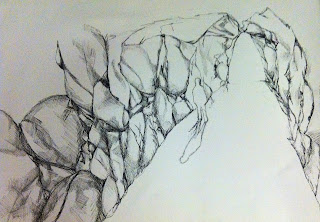Professor at TCNJ
Brief Bio
- first place in an art contest
- SVA- School of VIsual arts, high school never gave him a lot of direction
- he was at first intimidated, but stuck through and was named best graphic design student
- advertising, not a fan, but he didn't know why. Then he found graphic design, because it was art and not just business sketches.
- not just creating a concept
- all marker drawn.
- envelopes
CBS TV
- typographic titles
- age 22 using all different services
- vendors were then catering to his needs. Lots of staff when working for a big company
- Movie ads, only a few hours to complete.
- training to work on your toes, work faster.
SHOWTIME
- literally the art department
- freedom and open to his ideas
- left after a short time, quit
- networking with other channels and old bosses
- took an office in mid town, with a person from showtime and a person from CBS
- dont have 3 designers start a business, needed more diversity i.e. accounting or business
- computers were beginning to come into play
- Transition to the first macintosh
- tutortials for his computer to learn how to use software.
- TV shows
- Princeton NJ
- Allen Brooks Design
- different cliental
- Transition to corporate, get in the middle so it looks different and not like ever other pharmaceutical annual report
- Expand the business- partner who knows marketing and sales
- VERGE180
- every company is on the verge of something, failure, success, change. Help these people see the new marketing and advertising ideas.
- never to specialize in any area of design or any industry- because he never wanted to be pigeonholed.
- Branding Company
- What is a brand identity? Outward impression of the brand
When logos change.. the branding changes
CASE STUDY
- Tower Water Management
- new logo
- protects pipes and heating and cooling infrastructure through proper treatment of water
- Cut out management.. first
- every competitor uses blue
- Pipes and water make the best element
- not just the logo, give it an environment
- 3- 6 logo designs
CREATIVE PROCESS
- Laborers 55
- green materials for old homes
- sketch
- keep sketching because the ideas come out and just keep going. there is a lot of nothing but the more you work it out the better ideas can come
- look at references
- sketch more
- then hang on a wall and do further development
- you need a sense of where you want to go
DISCOVERY
- Do your research
- the project almost designs itself, so you learn what they like and what they dont want
- MESSAGE?
- BENEFITS?
- AUDIENCE?
- PERSONALITY?
McGraw- HIll Federal Credit Union
- Credit union, like a bank
- financial services
- most ambitious of their logo
- word of moth or referrals, weekly networking group. events.
- cold calls- least effective
- Linkedin- effective but tedious
How to rework a logo without totally changing it, keep it new but referencing the old?
- present it in a way that everyone is on the same page, then you expose it to the customers
- nothing bad happened, its not that things are changed just an upgrade.




.JPG)


















